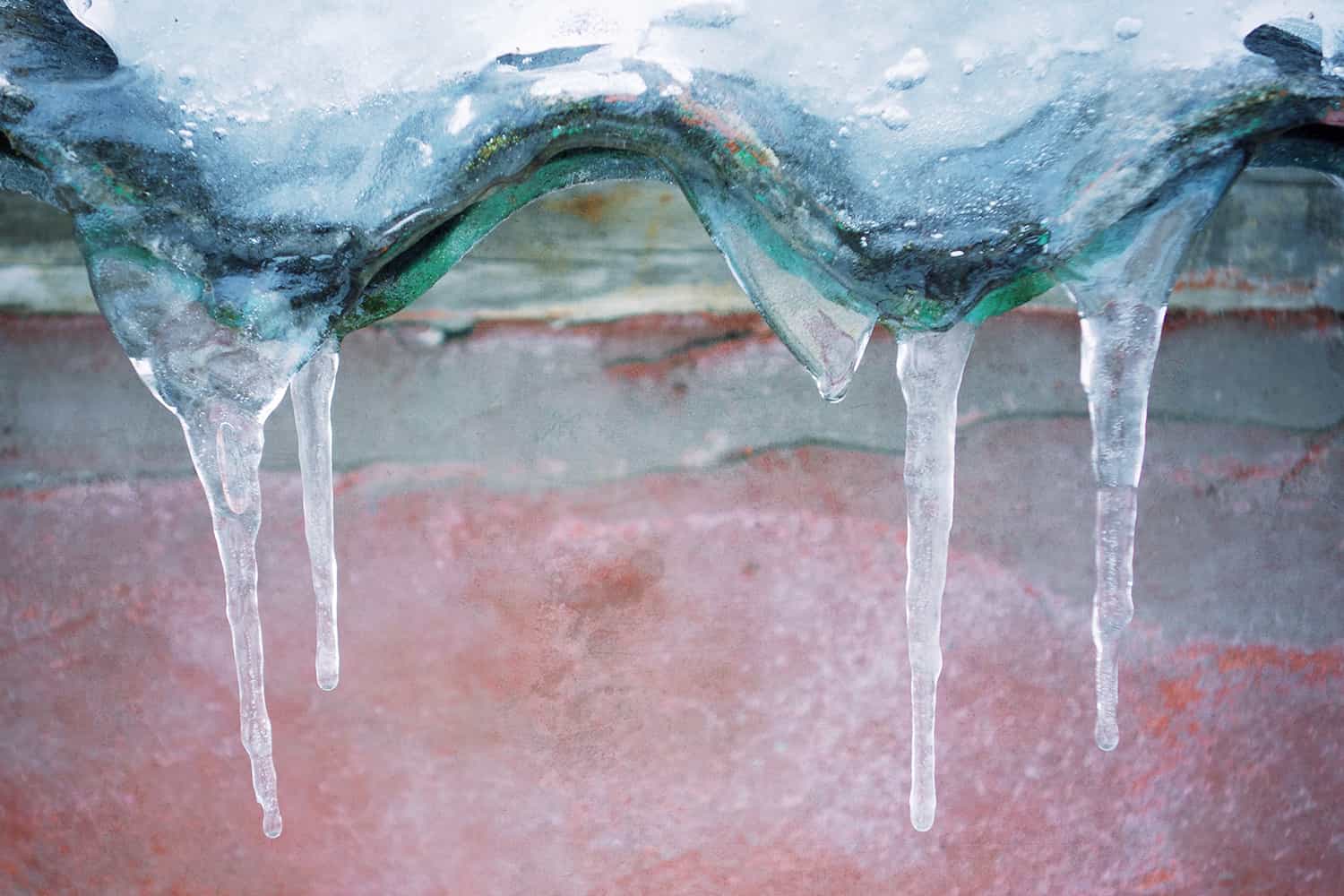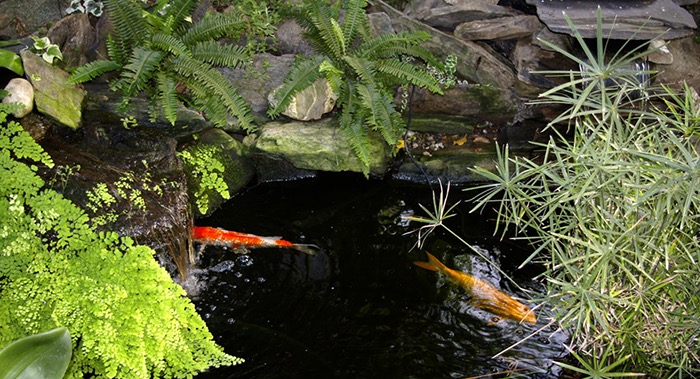Overwintering Koi & Fish Ponds 8 Hints

Advice on Overwintering Koi & Fish Ponds
Winter Pond Koi Keeping & Freezing Pond Water
in the USA & UK
Feeding Whilst Overwintering Koi
Koi (Carp) are built to withstand very cold water and that means water which is actually frozen over for long periods of time in extreme winter weather.
However it’s important to maintain vigilance and carry out some basic koi pond care. Probably the most important thing to be done to ensure your koi or goldfish get through the winter in good condition is to make sure that you pond is cleared of debris long before winter arrives and generally put into good condition.
Overwintering Koi means cleaning your pond (and bio-filter) in Autumn. This is an essential overwintering chore to do.
The last thing needed to maintain health in a closed koi pond system is a high population of intrinsically harmful bacteria living in dormancy in the 2 inches of settled debris at the bottom of the koi pond.
Consider buying a suitable pond vacuum (see below) to keep the bottom of your pond clear of organic and inorganic debris which looks unsightly and is a breeding ground for anaerobic and pathogenic bacteria.
These potentially harmful bacteria have a habit of reaching infectious levels once warmer temperatures of pond water are experienced in Spring. It just so happens that this coincides with koi which have withstood a harsh winter not being in the ideal condition to ward off a potentially serious bacterial pond water attack.
Koi Pond Test Kits. Testing pond water can in itself become an intriguing and interesting hobby. Get a reliable test kit now.
Ideas for OverWintering Koi and Pond Care
Feeding of koi in winter should be avoided. It is unnecessary and I’m told that koi can live 150 days quite easily without artificial food. If you’ve fed your koi or goldfish well in summer and put them on a leaner diet of wheatgerm in autumn you will have done a good job of getting your koi fish ready for winter dormancy caused by severe drops in fish pond water temperature.
Overwintering Koi start to become lethargic at temperatures as low as 10° C and at 8° degrees have probably stopped moving around very much at all. As temperatures fall lower for prolonged periods the koi will start to move less and less until eventually the koi (and to a lesser extent goldfish) sink to the bottom of the pond and enter a virtually motionless state. The koi have started to conserve energy for a prolonged period.
In the long run the most expensive part of fish pond keeping is the cost of food. It pays to buy the best yet most economical. These Koi Food items below are fantastic value for money in modern sensible koi food packaging.
Koi Food Wheatgerm is a great koi food for use in the autumn months and also for occasional use in tiny quantities for those days in winter when the sun shines, conditions are breezy, the pond water warms and the fish start to move.
If you’ve cleaned out all the muck and debris out of the pond and biofilter created by the those windborne falling leaves, in their once splendid autumn colours, bird droppings, fish faeces, soil, dead beasts, and whatever else found its way into the pond and you’ve given that biofilter a good clean out then you’re well on your way to tackle winter koi keeping.
Pond Vacuum
The pictures below are of the OASE, Intex and Laguna pond vacuum models but there are a few different kinds you can choose from… from very cheap to the very expensive OASE Pondovac models are the best by far but also the most expensive.
It’s important to clean out the settled debris in the fishpond since it will be a source of pathogenic bacteria in the spring when weather starts to warm up and all of God’s creatures, good and bad, wake up as well.
Here are a few pond vacuum options:
Autumn is also a very good time to get those aquatic plants cut back and if you have sub tropical water lilies it’s time to take them out of the koi pond and put them in a warmer place.
Here Comes Winter. How Come my Koi Don’t Die in a Frozen Pond?
As I write this the US & UK have already had a week of relentless snow and cold weather. On one day something like 40% of the working population couldn’t get to work (or didn’t want to) because of the severe snow and wintery weather. Those gentle autumn frosts in October quickly became blizzard-like, sub zero and prolonged low temperature heavy-frost nights. Pond water started to freeze and stay frozen providing a thickening window through which to watch your koi lying motionless in water that now has a temperature of exactly 4°C/39.2°F.
How do I know the water temperature is 4°C/39.2°F and not closer to freezing? Well the answer is that water exhibits an important physical characteristic in that at 4°C/39.2°F it reaches a maximum density and therefore sinks. Ice thus forms at the cold zero degree surface and as this low temperature is maintained the ice gets thicker but the rate of ice formation reduces dramatically because water below the ice surface is insulated by the ice layer. As the ice gets thicker it also starts to form more slowly until an equilibrium point is reached
It is in this 4°C/39.2°F layer that the koi, gold fish or other pond fish bide their time until more favourable conditions are experienced. This remarkable and unique property of water allows the world to survive and not only koi or goldfish.
Koi don’t mind cold winter weather. They are used to it. Koi and goldfish “hibernate” by remaining motionless on the bottom of the garden pond whose water is now exhibiting crystal clarity (no need for that UV pond clarifier this winter).
Your Koi’s metabolism has slowed to almost a stop, they don’t need food and they use up hardly any energy in their motionless state. Your koi and goldfish have started to hibernate.
Under these frozen pond water conditions the metabolic processes of koi, goldfish and most aquatic life has slowed to an almost stop. The koi or goldfish and other fish use little energy through their motionless behavior and the dramatic slowing in metabolism.
Noxious Gases
In any frozen pond it’s important to release any build up of noxious gases by if at all possible by maintaining a small hole in the ice layer. BUT don’t crash and bang the ice layer to achieve this.
To vent the pond of noxious gases that build up under the ice surface consider using a simple low cost floating device that keeps a hole open for overwintering koi.
Floating Ice Preventer
There are simple low cost pond water floating devices that allow a hole in the koi pond water ice surface to be maintained to allow these noxious gases to escape from pond water whilst overwintering koi. There are also low wattage (100 Watts) “pond heaters” that maintain a hole in the ice surface.
Here are a few floating ice preventers to help overwintering koi
In the US where we have many swimming pools suitable for swimming in summer but damn cold in winter heat is conserved by floating the equivalent of strong bubble-wrap on the pond surface. This technique can quite easily be adapted to conserve heat in a winter koi pond and the koi will probably benefit from this approach.
Some areas also have the luxury of almost continuous sunshine in winter making all sorts of solar heating options available for serious pond keepers. Now winter solar in the UK… I’m not too sure of that!
A golden rule… don’t feed koi, or gold fish in winter. Just don’t!
Keep Overwintering Koi in the Spare Room
I know it gets cold in that spare bedroom but it’s warmer than outside. If you do this make sure you use pond water and not tap water and do not feed the koi fish at all under any circumstances.
Where has All the Blanketweed and Algae Gone?
One of the things you may well notice about your koi pond and especially so if you had suspended algae in your fish pond during summer… like a miracle the pondwater becomes crystal clear and free of that nasty blanket weed experienced in summer. Why does the water in the fish pond clarify so much? The answer is that suspended algae causing green murky water or blanketweed algae like most other life forms in the pond also have metabolic systems that slow down in cold water and darker shorter days.
Here are some important algae treatments when overwintering koi:-
This appearance of clear winter pond water does not mean the koi pond algae problem is solved. Unless the problem of both algae and blanket weed is solved one or maybe both of these algae problems will return with a vengeance as the fish pond water warms up and sunlight hours extend next spring and summer. This would be a good time to add some Natural Waterscapes Muck Remover.
A treatment with this will reduce the nitrate levels down to zero making algae formation (blanketweed or suspended algae) much less likely next summer.






